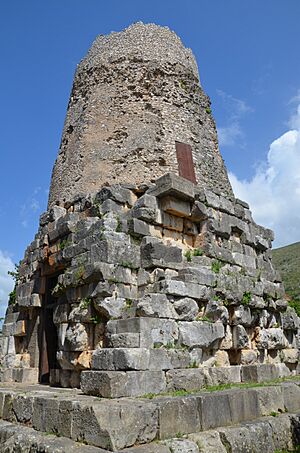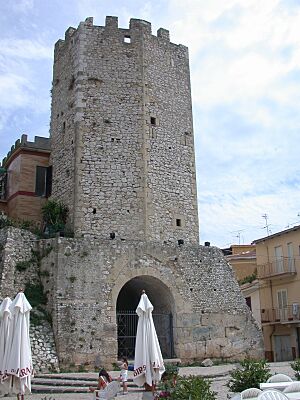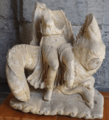Formia facts for kids
Quick facts for kids
Formia
|
|
|---|---|
| Comune di Formia | |
| Country | Italy |
| Region | Lazio |
| Province | Latina (LT) |
| Area | |
| • Total | 73 km2 (28 sq mi) |
| Population
(31 July 2021)
|
|
| • Total | 37,244 |
| • Density | 510/km2 (1,321/sq mi) |
| Time zone | UTC+1 (CET) |
| • Summer (DST) | UTC+2 (CEST) |
| Patron saint | St. Erasmus and St. John |
| Saint day | June 2 and June 24 |
Formia is an ancient city located in the province of Latina, in the Lazio region of Italy. It sits right on the Mediterranean Sea coast, about halfway between the famous cities of Rome and Naples. Formia is also found along the historic Appian Way, an important Roman road.
Contents
Ancient Stories of Formia
According to old myths, the city of Formia was founded by a character named Lamus. He was believed to be the son of Poseidon, the Greek god of the sea, and was also known as the king of the Laestrygones, a group of giant cannibals from ancient stories.
Formia's Rich History
Formia was first settled by an ancient Italian group called the Aurunci. The name Formiae likely comes from Hormia or Ormiai, which means "excellent landing place," because of its good harbor.
The city first appears in written history in 338 BC. After a conflict called the Latin Wars, Formia was given a special status by the Romans. It became a "Civitas sine suffragio", which meant its people were Roman citizens but couldn't vote. This happened because Formia stayed neutral during the wars. The nearby city of Gaeta was also part of Formia's territory back then.
Roman Resort Town
During the Roman Republic, Formia became a popular vacation spot for wealthy Romans. They built many fancy villas along the coast. The Roman poet Horace even called it "the city of the Mamurrae" because a rich and important Roman family, the Mamurra, owned a lot of land there. You can still see the impressive remains of these Roman villas stretching along the coast today.
Cicero's Connection to Formia
The famous Roman speaker and writer Cicero had a villa in Formia. Sadly, he was assassinated on the Appian Way just outside the town in 43 BC. His large tomb can still be visited today. The villa believed to be Cicero's has cool features like a nymphaeum (a grotto with water) and rooms decorated with old paintings and stucco.
Amazing Roman Structures
Formia has many other amazing Roman ruins. You can see parts of an amphitheater and a theater. There's also a huge underground cistern, which is a giant tank for storing water. It was dug 15 meters (about 49 feet) below ground and was probably the biggest Roman city cistern in the world for a long time!
Later History
After the Western Roman Empire fell, Formia was attacked by different groups. People moved to two smaller towns on a nearby hill, which were controlled by Gaeta. One town was called Mola di Gaeta, where Charles II of Anjou built a fortress. The other was Castellone, named after a castle built there in the mid-1300s.
These two towns were finally joined together again in 1863 and renamed Formia. However, the reunited city suffered a lot of damage during World War II, especially from bombings in 1943–44.
Formia's Geography
Formia is located on the Tyrrhenian Sea in the southern part of the Lazio region. It's very close to the town of Gaeta and near the border of the Campania region.
The area around Formia includes several smaller villages or "frazioni" like Castellonorato, Gianola-Santo Janni, Marànola, Penitro, and Trivio.
Main Places to See in Formia
Formia has many interesting historical sites and natural areas to explore:
- Tomb of Cicero: This is the most famous monument. It's a 24-meter (about 79-foot) tall tower on the old Appian Way, surrounded by a large ancient burial area.
- Tower of Mola: An old tower that was part of the Mola Castle.
- Tower of Castellone: Another historic tower from the Castellone area.
- Roman Cistern: One of the largest Roman cisterns in the world, dating back to the 1st century BC.
- Roman Villa Remains: You can see parts of the Roman Villa of Mamurra at Gianola, including large cisterns, aqueducts, and thermal baths.
- Church of San Giovanni Battista e Lorenzo: An old church known since 841, though it was mostly destroyed in World War II.
- Church of San Luca: This church, known since the 15th century, has a recently found crypt with old paintings.
- Renaissance Monastery and Church of Sant'Erasmo: Built where St Erasmus was believed to have been martyred.
- Archaeological Museum: A great place to see artifacts found in the area.
- Regional Park of Gianola and Mount of Scauri: A beautiful natural park for outdoor activities.
- Formia War Memorial: Features a large bronze sculpture called Sacraficio.
Sports in Formia
Formia is a well-known place for sports, especially athletics. It's home to the National Athletics School of the Italian National Olympic Committee, which opened in 1955. Famous athletes like Pietro Mennea and Giuseppe Gibilisco trained here.
Formia is also a great spot for cycling, including road cycling and mountain biking. You can easily access nearby parks like Parco Monte Orlando and Parco Naturale dei Monti Aurunci. For water lovers, Formia offers exciting sports like windsurfing and sailing.
Getting Around Formia
Formia is an important transportation hub in southern Lazio. The Rome–Formia–Naples railway runs through the Formia-Gaeta railway station. From here, you can take buses to nearby towns like Gaeta and Minturno.
If you want to visit islands, ferries and hydrofoils connect Formia to Ponza, Ischia, and Ventotene.
Formia's Sister Cities
Formia has several sister cities around the world. These partnerships help promote cultural exchange and friendship:
 Ferrara, Italy
Ferrara, Italy Fleury-les-Aubrais, France (since 2004)
Fleury-les-Aubrais, France (since 2004) Gračanica, Bosnia and Herzegovina
Gračanica, Bosnia and Herzegovina Haninge, Sweden
Haninge, Sweden Santeramo in Colle, Italy
Santeramo in Colle, Italy
Notable People from Formia
Some well-known individuals have connections to Formia:
- Antonio Sicurezza, a painter
- Vittorio Foa, a politician
- Amadeo Bordiga, a politician
- Dino Fava, a professional footballer
- James V. Monaco, a songwriter
Images for kids
See also
 In Spanish: Formia para niños
In Spanish: Formia para niños









